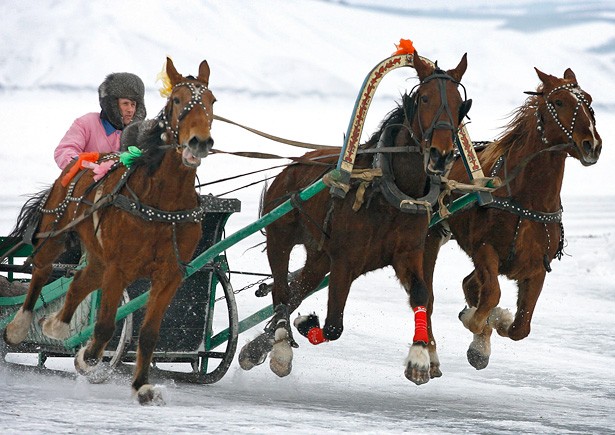
Update: Consider using tug stops on the shafts of single's vehicles to help disperse the load from breeching by using some pressure on the saddle to help slow and stop the forward motion of the vehicle. As potentially beneficial as it may be to have as little 'weight' on the saddle most of the time, it may also prove to be beneficial in the long run to share some of the vehicle stopping forces between the saddle and the breeching. Thank you, Elsie Rodney, for pointing my thinking in that direction. 9-1-11
Consider the stresses placed on the sacroiliac joint and pelvis of the single driving horse. These structures play a primary role in the transfer of the power developed from the hind legs to propel the horse and carriage and humans forward, they also perform the integral function of transferring the weight of the carriage and humans via the breeching to the horse for braking purposes. Breeching forces at the extreme moments of performance may take these structures to and beyond their limit causing compounding damage over time.
For some perspective, consider the single standardbred race horse. There is NO braking force occurring in their performance. It’s all forward. Now visualize the single combined driving horse with several hundred pounds of vehicle and human weight with the breeching forces shoving the horse from behind in the extremes of full gallop turns on a side hill in a Combined Driving marathon obstacle. These forces are not always symmetrical or predictable to the horse. Imagine yourself running on uneven ground (i.e with each foot on a different elevation) when, out of nowhere, you are shoved to the side from an angle from behind. Do this enough ties and your chances of injury are quite high. It's not hard to imagine the high toll that is taken on the pelvic structures of the equine.
While the following concerns the sacroiliac joint and pelvis, it is similar to the injury cycle of other structures of the horse.
THE INJURY CYCLE – Initial Sprain or over stretch injury Pain and inflammation • Powerful muscle spasm to protect or guard the joint during this painful stage • Pain and inflammation resolve • Powerful muscle spasm remains holding the joint in an abnormal position • Increased stress through the joint, because it is rotated or sitting in an abnormal plane • Arthritic changes set in • Another bout of pain and inflammation occur due to the arthritis and the cycle REPEATS.
Each time the cycle repeats the muscles get tighter, further affecting the function of the sacroiliac joint, pelvis and spine. In summary, the initial sprain leads to a pelvic rotation, which leads to a loss of function. The horse then has to compensate for this rotation at the pelvis, placing abnormal stresses on a whole new set of joints and causing further problems.























